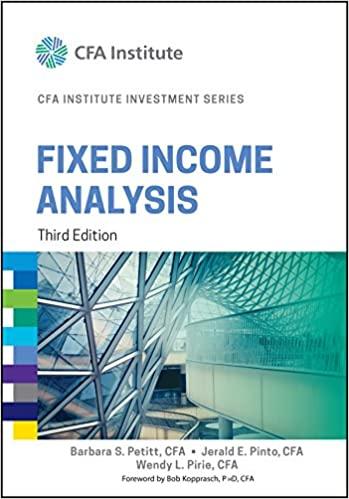In response to Palmes two fi nal questions, the levered portfolios range of returns and sixmonth return
Question:
In response to Palme’s two fi nal questions, the levered portfolio’s range of returns and sixmonth return when compared to the unlevered portfolio most likely would be:
Levered Portfolio Range of Returns Levered Portfolio Six-month Return A. narrower lower B. narrower higher C. wider lower Th e following information relates to Questions 17–22 and is based on “Fixed-Income Portfolio Management—Part I” and this chapter Th e investment committee of the US-based Autónoma Foundation has been dissatisfi ed with the performance of the fi xed-income portion of their endowment and has recently fi red the fi xed-income manager.
Th e investment committee has hired a consultant, Julia Santillana, to oversee the portfolio on an interim basis until the search for a new manager is completed. She is also expected to assess the portfolio’s risks and propose investment ideas to the committee.
Total Return Analysis and Scenario Analysis During a meeting between Santillana and members of the committee, a member asks her to discuss the use of total return analysis and scenario analysis before executing bond trades. In her response, Santillana states:
• “To compute total return, the manager needs a set of assumptions about the investment horizon, the expected reinvestment rate, and the expected change in interest rates.”
• “If the manager wants to evaluate how the individual assumptions aff ect the total return computation, she can use scenario analysis.”
• “Scenario analysis can lead to rejection of a strategy that is acceptable from a total return perspective.”
Use of Repurchase Agreements During the meeting, Santillana reviews with the investment committee a hypothetical transaction in which leverage is used. A manager with $2 million of funds to invest purchases corporate bonds with a market value of $7 million. To partially fi nance the purchase, the manager enters into a 30-day repurchase agreement with the bond dealer for $5 million. Th e 30-day term repo rate is assumed to be 4.20 percent per year. At the end of the 30 days, when the transaction expires, the corporate bonds are assumed to have increased in value by 0.30 percent. Santillana uses this information to demonstrate the eff ects of leverage on portfolio returns.
Responding to a question asked by a committee member, Santillana explains: “Th e quality of collateral as well as short sellers’ positions aff ect the repo rate.”
International Bond Investing and Hedging Santillana also mentions to the investment committee that the Foundation’s current portfolio does not include international bonds. She describes the benefi ts of investing in international bonds and answers the committee’s questions. Exhibit 1 displays information she uses during the meeting to clarify her answers. Th e 1-year interest rate is used as a proxy for the risk-free rate.
EXHIBIT 1 Summary Information Relevant to International Bond Investing UK Japan Germany Singapore US 1-year interest rate (percent) 6.24 0.97 4.69 2.09 5.30 Yield on 10-year government bond/note (percent) 5.04 1.67 4.36 2.74 4.62 Expected one-year currency appreciation in percent (USD per local currency)
0.10 0.50 0.95 1.60 N/A 10-year bond duration 7.34 9.12 7.72 8.19 7.79 Th e committee is persuaded by Santillana’s presentation and decides to invest in international bonds. As a result, Santillana considers whether she should recommend currency hedging using forward contracts, assuming that interest rate parity holds.
During the discussion on international bond investing, a member comments that investors in Japan and Singapore in particular should be investing in the United States because of the diff erence in bond yields. Santillana agrees but explains that investors should also perform a breakeven spread analysis when investing internationally.
Step by Step Answer:

Fixed Income Analysis
ISBN: 9788126563128
3rd Edition
Authors: Barbara S. Petitt, Jerald E. Pinto, Wendy L. Pirie, Bob Kopprasch






